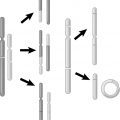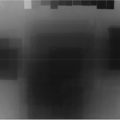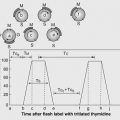13
FACTORS INFLUENCING TUMOR CONTROL AND COMPLICATIONS
DAESUNG LEE
Question 1
Quantitative radiobiology is based on a target model. What is the major target in cells for radiation-induced cell killing?
Question 3
If we have a small tumor measuring 1 cm in diameter with 109 cells and if a radiation dose of 6 Gy will kill 90% of cells, how many fractions of 6 Gy are necessary for a 90% chance of tumor control if there is no repopulation of cells between each dose?
Question 1 Quantitative radiobiology is based on a target model. What is the major target in cells for radiation-induced cell killing?
Answer 1
A target theory is based on modeling that radiation induces cell killing by hitting specific targets in the cell. The major target is nuclear DNA. DNA double-strand breaks are the most important damage, leading to possible cell killing at the time of reproduction (mitotic cell death). However, other molecular events such as clustered single-strand breaks, DNA base damage, DNA–DNA crosslinks, and DNA–protein cross links can also possibly lead to mitotic cell death or trigger p53-mediated or p53-independent pathways to apoptosis.
Prise KM, Schettino G, Folkard M, Held KD. New insights of cell death from radiation exposure. Lancet Oncol. 2005;6:520–528.
Zhoa L, Mi D, Hu B, Sun Y. A generalized target theory and its applications. Sci Rep. 2015;5:14568.
Question 3 If we have a small tumor measuring 1 cm in diameter with 109 cells and if a radiation dose of 6 Gy will kill 90% of cells, how many fractions of 6 Gy are necessary for a 90% chance of tumor control if there is no repopulation of cells between each dose?
Answer 3
The proportion of surviving cells is 10% after each fraction. So after the first fraction, 109 × 0.1 = 108 cells survive. After the second fraction, 108 × 0.1 = 107 cells, do. After the third, 106 cells, and so on. If we continue, after nine fractions, one cell will survive and another fraction of 6 Gy will give a 90% chance of that cell being killed. Therefore, 10 fractions of 6 Gy will give a 90% chance of tumor control.
Halperin EC, Wazer DE, Perez CA. The discipline of radiation oncology. In: Halperin EC, Wazer DE, Perez CA, Brady LW, eds. Perez and Brady’s Principles and Practice of Radiation Oncology. 6th ed. Philadelphia, PA: Lippincott Williams & Wilkins; 2013:2–60.
Question 4
The total radiation dose necessary to control a tumor depends on the initial number of tumor cells (volume) and radiosensitivity of tumor cells (proportion of cells killed for a given dose of radiation). Why might a large gross tumor require a higher dose than predicted?
Question 6
How much dose would be necessary to treat a patient with positive surgical margins for the same type of cancer as in question 5?
Question 4 The total radiation dose necessary to control a tumor depends on the initial number of tumor cells (volume) and radiosensitivity of tumor cells (proportion of cells killed for a given dose of radiation). Why might a large gross tumor require a higher dose than predicted?
Answer 4
One possible reason is the proportion of hypoxic cells. There is an inverse relationship between the size of the tumor and oxygen pressure. Higher proportions of hypoxic cells in large tumors will require higher doses as the radiosensitivity decreases by a factor of two to three in hypoxic cells. Another possible reason is repopulation. In some tumors, accelerated repopulation is triggered after a certain time. Larger tumors will require more prolonged treatment time if the same dose per fraction is used. Higher total dose may be required to account for additional cells generated by accelerated repopulation.
Steel GG, Peacock JH. Why are some human tumours more radiosensitive than others? Radiother Oncol. 1989;15:63–72.
Vaupel P, Kelleher DK, Hockel M. Oxygen status of malignant tumors: pathogenesis of hypoxia and significance for tumor therapy. Treatment resistance of solid tumors: role of hypoxia and anemia. Semin Oncol. 2001;28:29–35.
Question 6 How much dose would be necessary to treat a patient with positive surgical margins for the same type of cancer as in question 5?
Answer 6
It is estimated that a pathologist can detect malignancy microscopically when cell aggregates are larger than 106 cells/cm3 Therefore, a higher dose than used in subclinical disease is necessary for treating microscopic disease. In addition, when it is in the surgical bed, a higher dose is required for comparable control to a similar number of cells in the intact tumor bed. Therefore, a dose in the range of 60 to 66 Gy would be appropriate.
Ang KK, Adam GS. Radiotherapy for Head and Neck Cancers. 2nd ed. Philadelphia, PA: Lippincott Williams & Wilkins; 2002:80–104.
Halperin EC, Wazer DE, Perez CA. The discipline of radiation oncology. In: Halperin EC, Wazer DE, Perez CA, Brady LW, eds. Perez and Brady’s Principles and Practice of Radiation Oncology. 6th ed. Philadelphia, PA: Lippincott Williams & Wilkins, 2013:2–60.
Question 7
Suppose your patient has a 1 cm tumor with an estimated number of cancer clonogens of 107 cells. Estimated tumor control probability (TCP) is 10% at 52 Gy, 50% at 58 Gy, and 90% at 64 Gy. You prescribed 66 Gy in 2 Gy per fraction for definitive treatment. About halfway through treatment at 32 Gy, the patient has decided to quit treatments. He is asking you if his efforts for 3 weeks of treatment did anything good. What would be your answer?
Question 9
When tumor control probability (TCP) is plotted against dose, we see a sigmoid curve. TCP curves from experimental animal data are steep; however, those for human tumor control are much shallower and a given dose of radiation can produce a wide range of responses. What are some possible sources of such heterogeneity in actual tumor characteristics?
Question 7 Suppose your patient has a 1 cm tumor with an estimated number of cancer clonogens of 107 cells. Estimated tumor control probability (TCP) is 10% at 52 Gy, 50% at 58 Gy, and 90% at 64 Gy. You prescribed 66 Gy in 2 Gy per fraction for definitive treatment. About halfway through treatment at 32 Gy, the patient has decided to quit treatments. He is asking you if his efforts for 3 weeks of treatment did anything good. What would be your answer?
Answer 7
Unfortunately, with 32 Gy, his gross tumor may regress in size, but the chance for cure is close to 0%. For gross disease with a certain number of clonogens, there is a minimum threshold dose above which you start to have a chance of killing the last standing clonogen cell. Because cell killing is a random process, you need to combine the probability of getting to that last standing cell and probability of killing that last standing cell with an additional radiation dose to generate TCP at a given dose. For the aforementioned example, you’re not likely to see tumor control at doses lower than 50 Gy.
McBride WH, Withers HR. Biologic basis of radiation therapy. In: Halperin EC, Wazer DE, Perez CA, Brady LW, eds. Perez and Brady’s Principles and Practice of Radiation Oncology. 6th ed. Philadelphia, PA: Lippincott Williams & Wilkins; 2013:61–88.
Question 9 When tumor control probability (TCP) is plotted against dose, we see a sigmoid curve. TCP curves from experimental animal data are steep; however, those for human tumor control are much shallower and a given dose of radiation can produce a wide range of responses. What are some possible sources of such heterogeneity in actual tumor characteristics?
Answer 9
The heterogeneity in actual tumor characteristics may be a result of molecular differences in cancer and proportion of cancer stem cells. This will lead to differences in intrinsic radiosensitivity, redistribution and repopulation kinetics, and reoxygenation rates, as well as the overall response to radiation treatment.
McBride WH, Withers HR. Biologic basis of radiation therapy. In: Halperin EC, Wazer DE, Perez CA, Brady LW, eds. Perez and Brady’s Principles and Practice of Radiation Oncology. 6th ed. Philadelphia, PA: Lippincott Williams & Wilkins, 2013:61–88.
Stay updated, free articles. Join our Telegram channel

Full access? Get Clinical Tree






